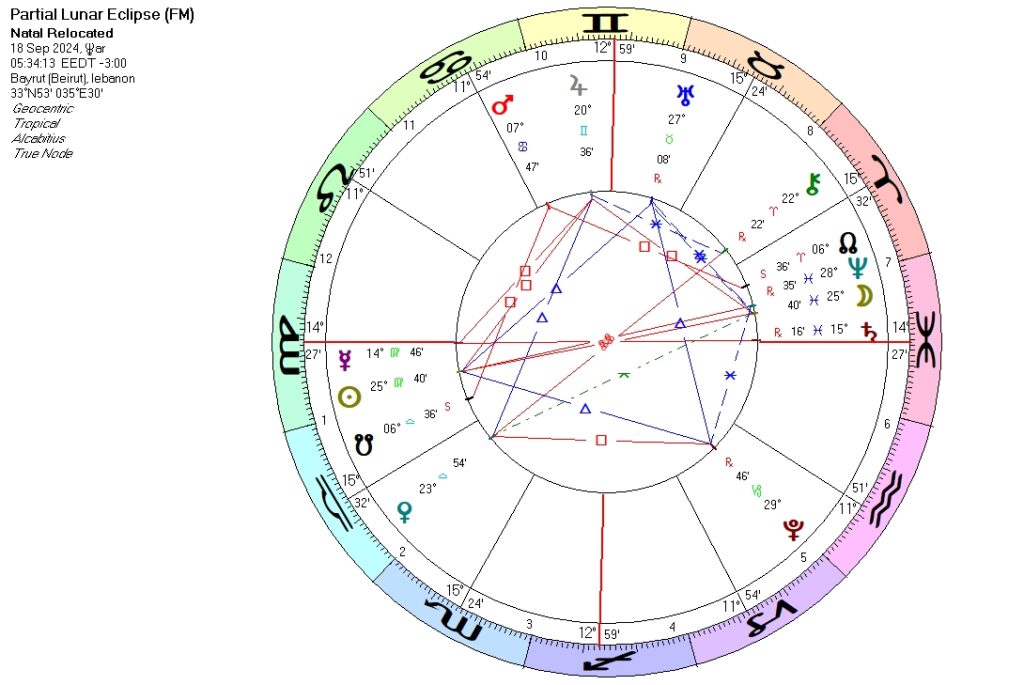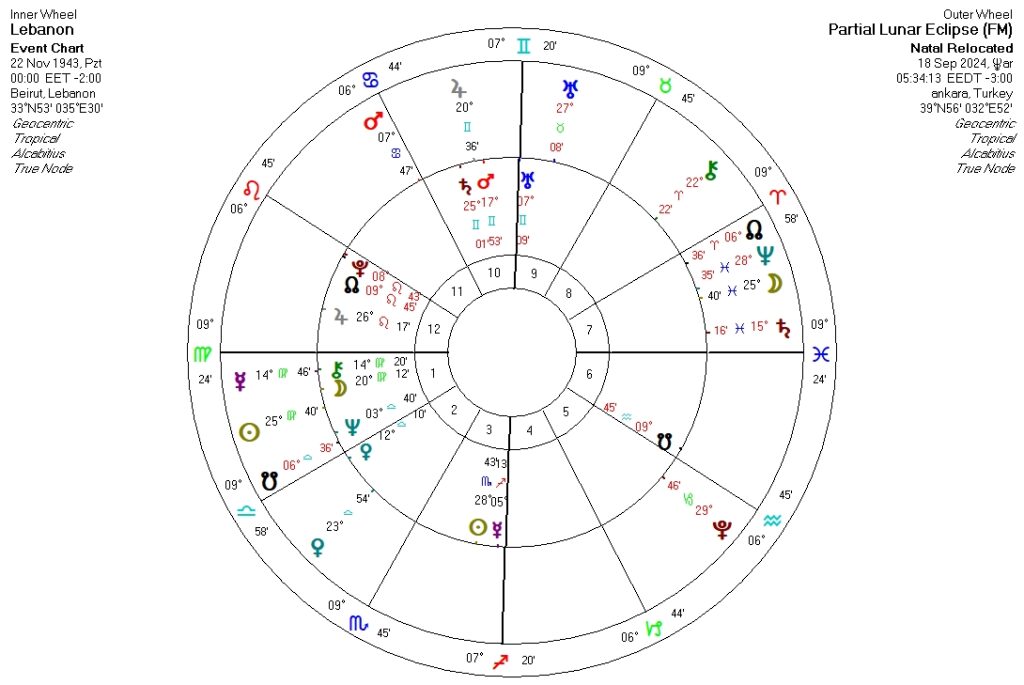Astrological techniques have long been used to explore geopolitical events, and antiscia, a lesser-known method, offers profound insights into hidden or mirrored connections between planetary positions. This ancient technique, dating back to Hellenistic astrology, involves looking at planets that are equidistant from the solstitial points (0° Cancer and 0° Capricorn). Essentially, it reveals an unseen yet potent connection between planets, sometimes exposing what lies beneath the surface of a situation.
In this article, we’ll examine how antiscia connections and other key astrological aspects shed light on a tragic event: the cyberattack on Lebanon, where thousands of pagers were remotely detonated in a coordinated bombing attack. This cruel and insidious act is reflected clearly in the lunar eclipse chart, where Mars, the planet of conflict, bombs, and aggression, takes center stage.
The Astrology of Lebanon’s Pager Bombing

On the day of the bombing, Mars was prominent in the lunar eclipse chart. The eclipse degree, 25° Pisces, is ruled by Mars in both the Egyptian bound system and the decan system. Moreover, Mars was forming a tense square aspect with the lunar nodes, intensifying its influence. The lunar nodes—often linked to fate, technology, and navigation—are particularly relevant in this event, as the attack was carried out remotely through a cyber system. This highlights Mars’ role as the aggressor, while the lunar nodes underscore the remote, technological nature of the attack.
When examining the antiscia aspect between Mars and Jupiter in the lunar eclipse chart, we gain even more insight into the dynamics of this devastating event. Mars at 7° Cancer forms an antiscia with Jupiter at 20° Gemini. Mars, in Cancer, a sign linked to personal belongings, could represent items that are kept close, such as pagers, while Jupiter in Gemini speaks to communication and, potentially, cyber warfare. The antiscia between these two planets suggests a covert but powerful connection—Mars signifies bombs and explosions, while Jupiter governs the medium through which the attack occurred: distant communication, cyber systems, and remote technologies.
The bombing attack in Lebanon, which saw pagers explode as though triggered by a bomb, mirrors this Mars-Jupiter antiscia perfectly. The distant, insidious nature of the attack—using a common communication device to carry out destruction—reflects the combination of these planetary energies.
Lebanon’s Natal Chart and the Eclipse

Looking at Lebanon’s natal chart in relation to the eclipse reveals further striking astrological connections. Lebanon’s Saturn-Mars conjunction is directly impacted by Jupiter at 20° Gemini through antiscia. Saturn and Mars, two malefic planets associated with authority and conflict, already suggest tension, and the added influence of Jupiter through antiscia highlights a magnification of this tension through technology and communication.
Moreover, Lebanon’s natal Moon at 20° Virgo forms a square to Jupiter and Mars, increasing the emotional and physical impact of the event on the country’s population. This exact square represents a clash between these forces, one that culminated in an unprecedented and cruel cyberattack. The Moon, which often represents the people in mundane astrology, shows how the population was directly affected by this catastrophic event.
The Role of the Lunar Nodes in Mundane Astrology
The square aspect between Mars and the lunar nodes in the eclipse chart should not be overlooked. The lunar nodes, which are determined by the intersection of the Moon’s orbit with the ecliptic, have long been linked to fate, direction, and destiny. However, in mundane astrology, they often represent technology, navigation systems, GPS, and anything related to remote control or directional tools. In this case, Mars squaring the nodes indicates a violent, sudden act carried out remotely.
The importance of the lunar nodes in technological and navigational contexts is evident in historical events. For example, during the collapse of the Baltimore Bridge, the lunar nodes were in a similarly significant position, highlighting their influence in events involving structures, technology, and guidance systems. Just as the lunar nodes played a role in the destruction of the bridge, here, they point to the remote detonation of pagers in Lebanon—a technological act of violence.
Astrologically, the lunar nodes are connected to the Sun and Moon’s orbits, marking the points where the two luminaries’ paths cross. This gives them a symbolic connection to direction and guidance, as they represent intersections of celestial bodies that determine not only eclipses but also broader cosmic alignments. In mundane astrology, this directional quality is applied to technology and systems of guidance, making the nodes vital in understanding events where navigation, GPS, or remote control is involved.
The Importance of Antiscia in Political and Mundane Astrology
The use of antiscia in mundane astrology cannot be understated. Historically, this technique has been employed to reveal hidden or mirrored events that otherwise go unnoticed in standard planetary configurations. The antiscia alignment between Mars and Jupiter in this lunar eclipse chart is a prime example of how these subtle planetary relationships can manifest in real-world events. In this case, the combination of Mars’ aggression with Jupiter’s expansion of communication systems created the perfect storm for a cyberattack.
Antiscia aspects, though not as widely discussed in modern astrology as trines or squares, offer valuable insights into secret or covert interactions. Their ability to reflect hidden connections makes them especially useful in mundane astrology, where political and global events often unfold behind the scenes, only to be revealed later.
In this case, the antiscia between Mars and Jupiter underscores the covert nature of the bombing—where a seemingly harmless object like a pager became the tool for a cruel and devastating attack. It demonstrates the power of astrology to unveil the hidden dynamics that influence global events.
Conclusion
The cyberattack in Lebanon that resulted in the explosion of thousands of pagers is a chilling reminder of the power of astrology to reflect real-world events. Through the analysis of the lunar eclipse chart, the antiscia between Mars and Jupiter, and the role of the lunar nodes in technological events, we see how ancient astrological techniques remain relevant in today’s modern world.
As astrologers, our task is to continue exploring these techniques, understanding their implications, and applying them to the events of our time. The tragic bombing in Lebanon, reflected so clearly in the astrological configurations of the moment, serves as a powerful example of astrology’s ability to uncover the forces at play behind the scenes.
Kenan Yasin Bölükbaşı
Experimental Astrologer
ISAR Cap, mAPAI, OPA, CIA Agent 104 and European Representative.
References
- H.S. Green, Mundane or National Astrology
- Nicholas Campion, Michael Baigent, and Charles Harvey, Mundane Astrology: The Astrology of Nations and States
- Chris Brennan, Hellenistic Astrology: The Study of Fate and Fortune
- Sue Tompkins, The Contemporary Astrologer’s Handbook (includes a section on antiscia and its practical applications)
- John Frawley, The Real Astrology (a notable discussion on antiscia in mundane astrology)
- ILKHA News: Hezbollah blames Israel for deadly cyberattack in Lebanon, vows retaliation. Last accessed on September 18, 2024.
- Jerusalem Post: Live Updates on Middle East Cyberattack. Last accessed on September 18, 2024.

